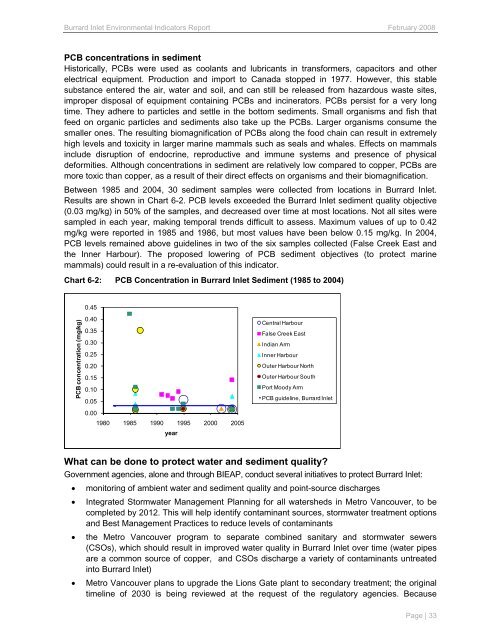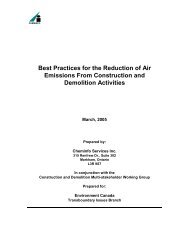Burrard Inlet Environmental Indicators Report - the BIEAP and ...
Burrard Inlet Environmental Indicators Report - the BIEAP and ...
Burrard Inlet Environmental Indicators Report - the BIEAP and ...
Create successful ePaper yourself
Turn your PDF publications into a flip-book with our unique Google optimized e-Paper software.
<strong>Burrard</strong> <strong>Inlet</strong> <strong>Environmental</strong> <strong>Indicators</strong> <strong>Report</strong> February 2008<br />
PCB concentrations in sediment<br />
Historically, PCBs were used as coolants <strong>and</strong> lubricants in transformers, capacitors <strong>and</strong> o<strong>the</strong>r<br />
electrical equipment. Production <strong>and</strong> import to Canada stopped in 1977. However, this stable<br />
substance entered <strong>the</strong> air, water <strong>and</strong> soil, <strong>and</strong> can still be released from hazardous waste sites,<br />
improper disposal of equipment containing PCBs <strong>and</strong> incinerators. PCBs persist for a very long<br />
time. They adhere to particles <strong>and</strong> settle in <strong>the</strong> bottom sediments. Small organisms <strong>and</strong> fish that<br />
feed on organic particles <strong>and</strong> sediments also take up <strong>the</strong> PCBs. Larger organisms consume <strong>the</strong><br />
smaller ones. The resulting biomagnification of PCBs along <strong>the</strong> food chain can result in extremely<br />
high levels <strong>and</strong> toxicity in larger marine mammals such as seals <strong>and</strong> whales. Effects on mammals<br />
include disruption of endocrine, reproductive <strong>and</strong> immune systems <strong>and</strong> presence of physical<br />
deformities. Although concentrations in sediment are relatively low compared to copper, PCBs are<br />
more toxic than copper, as a result of <strong>the</strong>ir direct effects on organisms <strong>and</strong> <strong>the</strong>ir biomagnification.<br />
Between 1985 <strong>and</strong> 2004, 30 sediment samples were collected from locations in <strong>Burrard</strong> <strong>Inlet</strong>.<br />
Results are shown in Chart 6-2. PCB levels exceeded <strong>the</strong> <strong>Burrard</strong> <strong>Inlet</strong> sediment quality objective<br />
(0.03 mg/kg) in 50% of <strong>the</strong> samples, <strong>and</strong> decreased over time at most locations. Not all sites were<br />
sampled in each year, making temporal trends difficult to assess. Maximum values of up to 0.42<br />
mg/kg were reported in 1985 <strong>and</strong> 1986, but most values have been below 0.15 mg/kg. In 2004,<br />
PCB levels remained above guidelines in two of <strong>the</strong> six samples collected (False Creek East <strong>and</strong><br />
<strong>the</strong> Inner Harbour). The proposed lowering of PCB sediment objectives (to protect marine<br />
mammals) could result in a re-evaluation of this indicator.<br />
Chart 6-2: PCB Concentration in <strong>Burrard</strong> <strong>Inlet</strong> Sediment (1985 to 2004)<br />
PCB concentration (mg/kg)<br />
0.45<br />
0.40<br />
0.35<br />
0.30<br />
0.25<br />
0.20<br />
0.15<br />
0.10<br />
0.05<br />
0.00<br />
1980 1985 1990 1995 2000 2005<br />
year<br />
Central Harbour<br />
False Creek East<br />
Indian Arm<br />
Inner Harbour<br />
Outer Harbour North<br />
Outer Harbour South<br />
Port Moody Arm<br />
PCB guideline, <strong>Burrard</strong> <strong>Inlet</strong><br />
What can be done to protect water <strong>and</strong> sediment quality?<br />
Government agencies, alone <strong>and</strong> through <strong>BIEAP</strong>, conduct several initiatives to protect <strong>Burrard</strong> <strong>Inlet</strong>:<br />
• monitoring of ambient water <strong>and</strong> sediment quality <strong>and</strong> point-source discharges<br />
• Integrated Stormwater Management Planning for all watersheds in Metro Vancouver, to be<br />
completed by 2012. This will help identify contaminant sources, stormwater treatment options<br />
<strong>and</strong> Best Management Practices to reduce levels of contaminants<br />
• <strong>the</strong> Metro Vancouver program to separate combined sanitary <strong>and</strong> stormwater sewers<br />
(CSOs), which should result in improved water quality in <strong>Burrard</strong> <strong>Inlet</strong> over time (water pipes<br />
are a common source of copper, <strong>and</strong> CSOs discharge a variety of contaminants untreated<br />
into <strong>Burrard</strong> <strong>Inlet</strong>)<br />
• Metro Vancouver plans to upgrade <strong>the</strong> Lions Gate plant to secondary treatment; <strong>the</strong> original<br />
timeline of 2030 is being reviewed at <strong>the</strong> request of <strong>the</strong> regulatory agencies. Because<br />
Page | 33
















